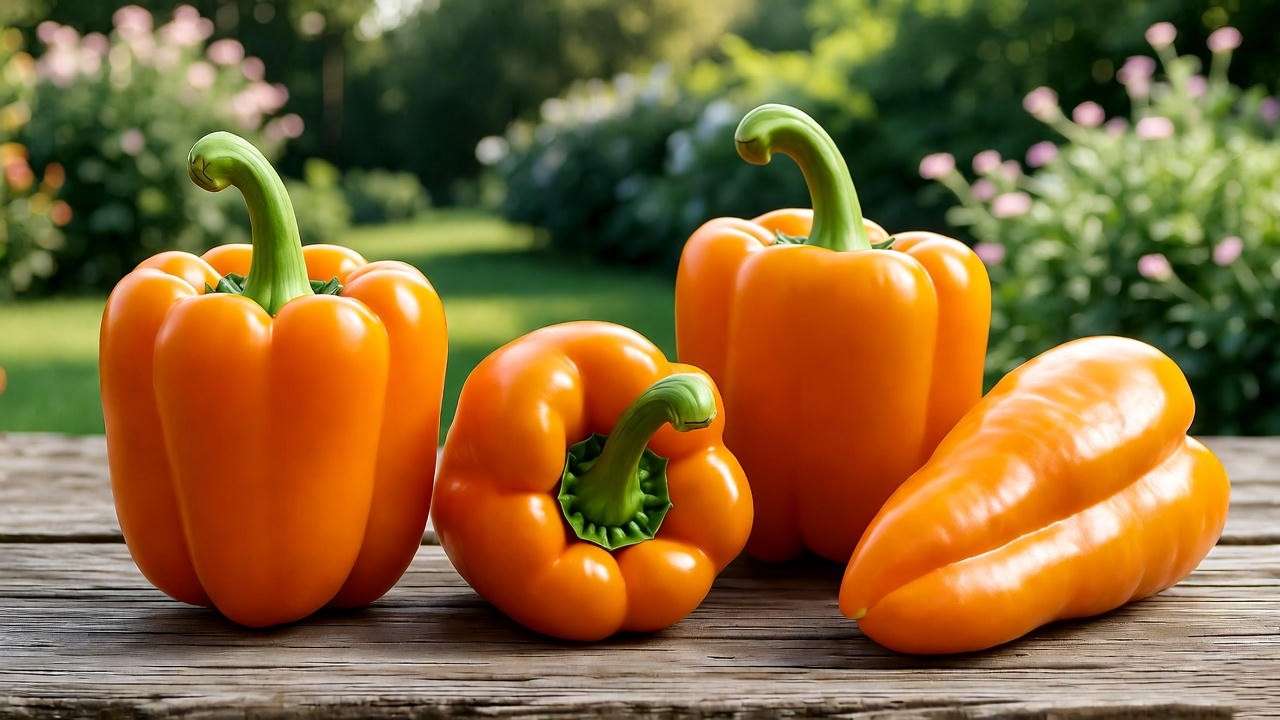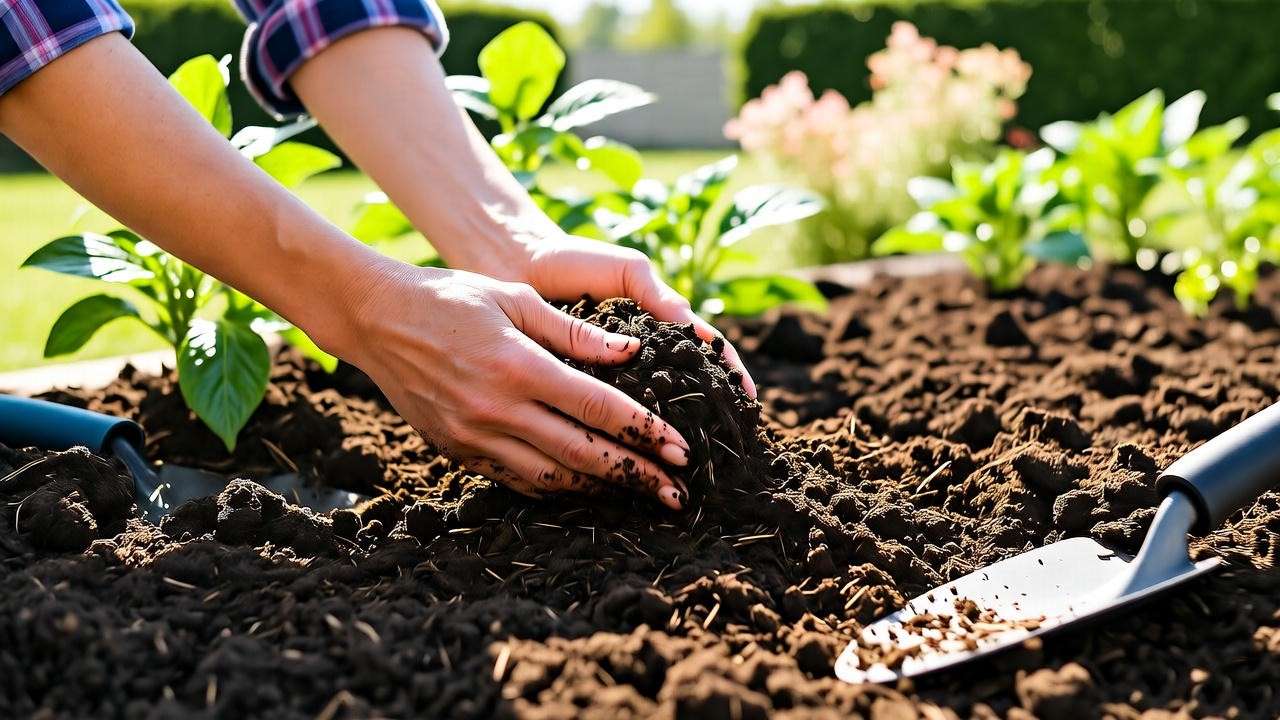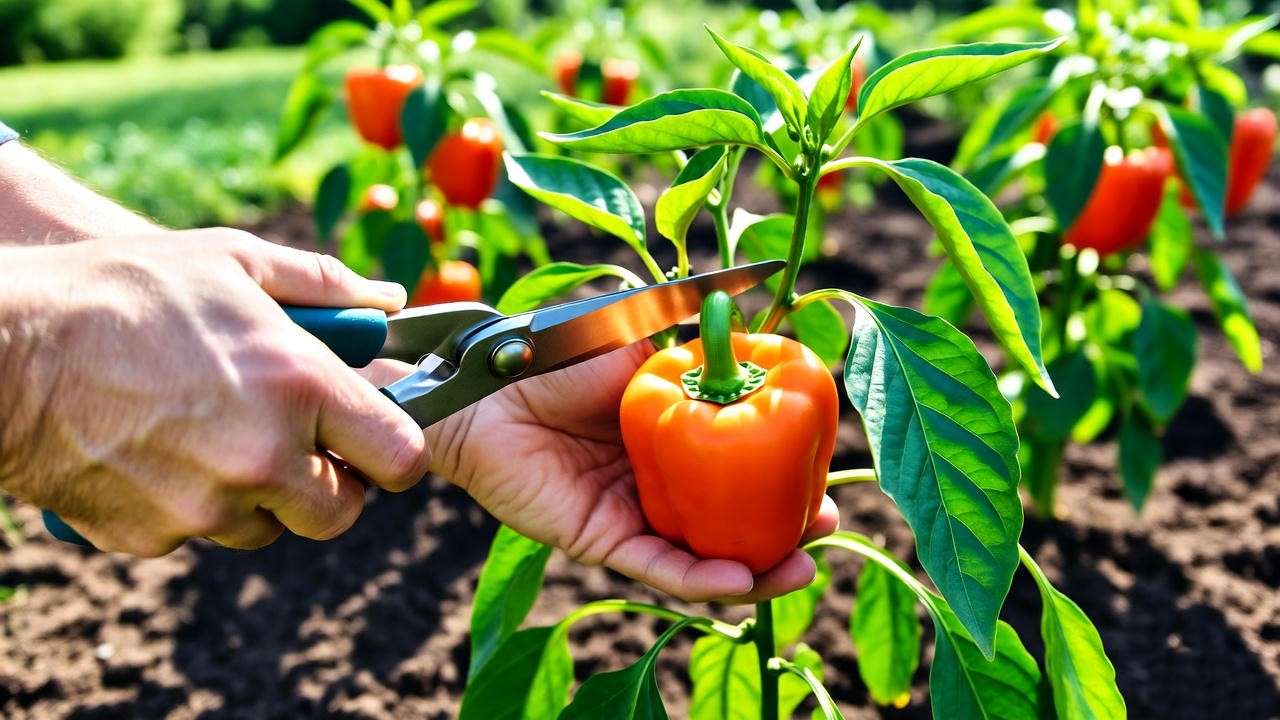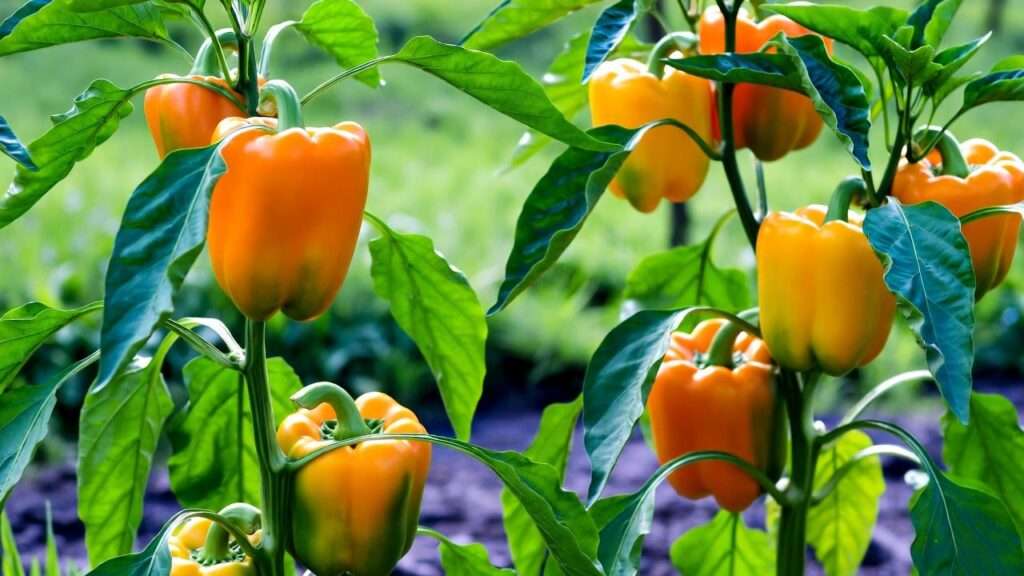Imagine slicing into a vibrant, sun-kissed orange bell pepper, its sweet, juicy crunch elevating your salads, stir-fries, or grilled dishes. Orange bell pepper plants are a gardener’s dream, offering not only stunning color but also a nutritional powerhouse packed with vitamin C and beta-carotene. Whether you’re a seasoned grower or a beginner, cultivating these beauties can transform your garden and kitchen. This comprehensive guide dives into everything you need to know to grow thriving orange bell pepper plants, from planting to harvesting, ensuring a bountiful yield. With expert insights backed by years of horticultural experience and research from trusted sources like university extensions, you’ll master the art of growing these vibrant veggies. Let’s get started! 🌞
Understanding Orange Bell Pepper Plants 🌶️
What Makes Orange Bell Peppers Unique? ✨
Orange bell peppers stand out for their sweet, mild flavor and eye-catching hue, making them a favorite for both culinary and ornamental gardening. Unlike their green counterparts, which are harvested before full maturity, orange bell peppers are ripened on the plant, developing a sweeter taste and higher nutrient content. They’re rich in antioxidants, particularly vitamin C (up to 190 mg per pepper) and beta-carotene, which supports eye health. Compared to red or yellow varieties, orange bell peppers offer a balance of sweetness and crunch, perfect for raw or cooked dishes. Their vibrant color also adds aesthetic appeal to gardens and plates alike.
Popular Orange Bell Pepper Varieties to Grow 🥗
Choosing the right variety is key to a successful harvest. Here are some top orange bell pepper varieties, each with unique traits:
- ‘Orange Blaze’: A disease-resistant hybrid, ideal for beginners, with medium-sized fruits and a sweet flavor. Matures in 65–70 days.
- ‘Horizon’: Known for large, blocky fruits and high yields, perfect for stuffing. Matures in 75–80 days.
- ‘Valencia’: Offers thick-walled peppers with a rich, sweet taste, great for roasting. Matures in 70–75 days.
Select a variety based on your climate and garden space. For example, ‘Orange Blaze’ thrives in humid regions due to its resistance to bacterial leaf spot, while ‘Horizon’ suits larger gardens. Check with local nurseries or extension services for region-specific recommendations.

Preparing to Grow Orange Bell Pepper Plants 🌞
Choosing the Right Location and Soil 🏡
Orange bell pepper plants thrive in full sun, requiring at least 6–8 hours of direct sunlight daily. Choose a spot sheltered from strong winds but with good air circulation to prevent fungal issues. Soil is equally critical: aim for well-draining, loamy soil with a pH of 6.0–6.8. Test your soil using a home kit or send a sample to your local extension service for precise results. Amend poor soil with organic matter like compost or aged manure to boost fertility and drainage. Avoid planting in areas prone to waterlogging, as soggy roots can lead to rot. A common mistake is underestimating sunlight needs—shade stunts growth and reduces fruit quality.

Timing Your Planting for Success ⏰
Timing is everything when growing orange bell peppers. Plant after the last frost in spring, when soil temperatures reach at least 65°F. For most USDA hardiness zones, this means late spring (April–May). Starting seeds indoors 8–10 weeks before the last frost gives plants a head start. Use a heat mat to maintain germination temperatures of 75–85°F for optimal sprouting (typically 7–14 days). Alternatively, purchase healthy transplants from a reputable nursery to save time. Avoid rushing—planting too early in cold soil can shock seedlings, delaying growth. For example, in Zone 7, aim to transplant in mid-May for best results.
Planting Orange Bell Pepper Plants Like a Pro 🌿
Step-by-Step Planting Guide 📋
Follow these steps for successful planting:
- Prepare the soil: Work in 2–3 inches of compost and a balanced fertilizer (e.g., 10-10-10) to enrich the bed.
- Space plants properly: Place seedlings 18–24 inches apart in rows 24–36 inches apart to ensure air circulation and room for growth.
- Plant at the right depth: Set transplants at the same depth as their nursery pots; bury seeds ¼–½ inch deep.
- Water thoroughly: Provide 1 inch of water immediately after planting to settle the soil.
For seeds, use a sterile seed-starting mix and keep soil moist but not soggy. Harden off transplants by gradually exposing them to outdoor conditions over 7–10 days to prevent shock. A well-spaced garden reduces competition for nutrients and sunlight, boosting yields.
Supporting Your Plants for Strong Growth 🏋️♂️
Orange bell pepper plants can grow 2–3 feet tall and produce heavy fruit, so support is essential. Install stakes or cages at planting to avoid disturbing roots later. Tomato cages or bamboo stakes work well—secure plants loosely with soft ties to allow flexibility. Mulching with straw or shredded bark retains moisture, suppresses weeds, and regulates soil temperature. For example, a gardener in Texas reported doubling their pepper yield by using cages and mulch to stabilize plants during windy summers. Check supports regularly to ensure they’re sturdy as fruits develop.
Caring for Orange Bell Pepper Plants 🌼
Watering and Fertilizing for Optimal Growth 💧
Consistent moisture is critical for orange bell pepper plants. Aim for 1–2 inches of water per week, adjusting for rainfall. Water deeply at the base, avoiding foliage to prevent fungal diseases. Drip irrigation or soaker hoses are ideal for even delivery. Overwatering can cause root rot, so ensure soil drains well. Fertilize with a balanced NPK fertilizer (e.g., 10-10-10) at planting, then switch to a low-nitrogen, high-phosphorus formula (e.g., 5-10-10) during flowering and fruiting to promote blooms and fruit set. Organic options like compost tea or fish emulsion work well for eco-conscious gardeners. Apply fertilizers every 4–6 weeks, following package instructions.

Pruning and Maintenance Tips ✂️
Pruning enhances air circulation and fruit production. Remove suckers (small shoots between the main stem and branches) and any yellowing or damaged leaves. Trim early flowers if plants are small to encourage stronger root and foliage growth. Use clean, sharp shears to avoid spreading disease. According to a 2023 study by the University of Florida Extension, pruning bell peppers increased yields by 15–20% in small gardens. Regularly inspect plants for signs of stress, such as wilting or leaf curl, and adjust care as needed.
Managing Temperature and Sunlight ☀️
Orange bell peppers love warmth but can suffer in extreme heat or cold. Ideal temperatures range from 70–85°F during the day and 60–70°F at night. In hot climates, use shade cloth during peak summer to prevent sunburned fruit. For unexpected cold snaps, cover plants with row covers or cloches. Signs of heat stress include drooping leaves or blossom drop—mitigate with evening watering and mulch. A gardener in Arizona successfully protected their peppers by using 30% shade cloth during 100°F+ days, maintaining healthy fruit production.
Tackling Common Pests and Diseases 🐞
Identifying and Preventing Pests 🕷️
Orange bell pepper plants can attract pests like aphids, spider mites, and pepper weevils, which can damage foliage and fruit. Aphids are tiny, soft-bodied insects that cluster on new growth, causing leaves to curl. Spider mites, barely visible, leave fine webbing and stippled leaves. Pepper weevils bore into fruits, ruining them. Regular inspection is key—check undersides of leaves and stems weekly. For organic control, spray neem oil or insecticidal soap, ensuring thorough coverage. Companion planting with marigolds or basil can deter pests naturally. For severe infestations, consult your local extension service for safe chemical options. Integrated Pest Management (IPM), recommended by the USDA, combines monitoring, cultural practices, and targeted treatments to minimize pest damage while protecting beneficial insects like ladybugs.

Combating Diseases for Healthy Plants 🦠
Diseases like blossom end rot, bacterial spot, and powdery mildew can threaten orange bell pepper plants. Blossom end rot appears as dark, sunken spots on fruit bottoms, often due to calcium deficiency or inconsistent watering. Prevent it by maintaining even soil moisture and adding calcium-rich amendments like gypsum. Bacterial spot causes dark, water-soaked lesions on leaves and fruit—remove affected parts and avoid overhead watering. Powdery mildew, marked by white patches on leaves, thrives in humid conditions; improve air circulation through proper spacing and pruning. Choose disease-resistant varieties like ‘Orange Blaze’ and rotate crops every 2–3 years to reduce disease risk. If needed, apply fungicides labeled for edible crops, following guidelines from trusted sources like Cornell University’s Plant Pathology Department.
Harvesting and Enjoying Your Orange Bell Peppers 🍊
When and How to Harvest 🥕
Orange bell peppers are ready to harvest when they turn a vibrant orange, feel firm, and measure 3–4 inches long, typically 65–80 days after transplanting. Green peppers can be picked earlier, but waiting for the orange hue maximizes sweetness and nutrition. Use clean, sharp shears to cut peppers from the plant, leaving a short stem to avoid damage. Harvest regularly to encourage continuous fruit production. For example, a gardener in California noted that picking peppers every few days led to a longer harvest season, yielding over 20 peppers per plant. Store freshly picked peppers in a cool, dry place or refrigerate for up to 2 weeks.

Storing and Using Your Peppers 🥗
To extend shelf life, store orange bell peppers in perforated plastic bags in the refrigerator’s crisper drawer for up to 2–3 weeks. For long-term storage, freeze whole or sliced peppers after blanching for 2–3 minutes to preserve flavor. Drying is another option—slice peppers thinly and use a dehydrator or low oven (135°F) for 8–12 hours. In the kitchen, orange bell peppers shine in stuffed pepper recipes, roasted vegetable medleys, or fresh salsas. Their high vitamin C content (up to 190 mg per pepper, per USDA data) makes them a healthy addition to any dish. Try this quick recipe: Roast orange bell peppers with olive oil, garlic, and herbs for a colorful side dish that pairs beautifully with grilled meats.
Troubleshooting Common Growing Challenges 🔧
Why Aren’t My Peppers Turning Orange? 🤔
If your peppers remain green, several factors could be at play. Insufficient sunlight (less than 6 hours daily) slows ripening, so ensure plants are in a sunny spot. Nutrient imbalances, like excess nitrogen, can prioritize foliage over fruit ripening—switch to a phosphorus-heavy fertilizer (e.g., 5-10-10). Cool temperatures below 60°F can also delay color change. Patience is key; peppers may take 2–3 weeks to transition from green to orange. If issues persist, test soil for nutrient deficiencies using a kit or consult your local extension service for tailored advice.
Dealing with Poor Yields or Small Fruits 😞
Low yields or undersized peppers often stem from overcrowding, inadequate fertilization, or water stress. Plants spaced too closely (less than 18 inches apart) compete for resources, reducing fruit size. Ensure proper spacing and stake plants to support heavy fruit loads. Inconsistent watering can cause small, misshapen peppers—maintain even moisture with drip irrigation or a soaker hose. Fertilize every 4–6 weeks with a balanced formula to support growth. A 2024 study from Texas A&M University found that correcting nutrient deficiencies increased pepper yields by up to 25% in home gardens. Monitor soil and adjust care routines accordingly.
Expert Tips for Maximizing Your Harvest 🚀
To elevate your orange bell pepper game, try these advanced strategies:
- Companion Planting: Pair peppers with basil, onions, or marigolds to repel pests and enhance growth. Basil, for instance, deters aphids while adding fragrance to your garden.
- Seasonal Adjustments: In spring, focus on root establishment with consistent watering. In fall, protect plants from early frosts with row covers to extend the harvest.
- Drip Irrigation: Install a drip system for precise water delivery, reducing waste and preventing foliar diseases. A gardener in Florida reported a 30% yield increase after switching to drip irrigation.
These techniques, grounded in horticultural research, can transform your garden into a pepper-growing powerhouse.
FAQs About Growing Orange Bell Pepper Plants ❓
Q: How long do orange bell peppers take to grow?
A: From transplanting, orange bell peppers take 65–80 days to reach full orange maturity, depending on the variety and growing conditions.
Q: Can I grow orange bell peppers in containers?
A: Yes! Use a 5-gallon pot with well-draining soil, ensure full sun, and water consistently. Choose compact varieties like ‘Orange Blaze’ for best results.
Q: What’s the best fertilizer for orange bell pepper plants?
A: A balanced 10-10-10 fertilizer at planting, followed by a 5-10-10 formula during flowering and fruiting, supports healthy growth. Organic options like fish emulsion also work well.
Q: Why are my pepper plants dropping flowers?
A: Flower drop can result from extreme temperatures (above 90°F or below 60°F), overwatering, or nutrient deficiencies. Adjust watering and fertilize appropriately.
Conclusion: Your Path to a Thriving Orange Bell Pepper Garden 🌈
Growing vibrant orange bell pepper plants is a rewarding journey that combines science, patience, and a touch of artistry. By choosing the right variety, preparing your soil, and providing consistent care, you’ll enjoy a bountiful harvest of sweet, colorful peppers. From tackling pests to mastering harvest timing, this guide equips you with expert-backed strategies to succeed. Start planting today, and share your progress in the comments or on social media—your garden could inspire others! For more plant care tips, explore our guides on growing tomatoes, cucumbers, and organic pest control. Happy gardening! 🌿













